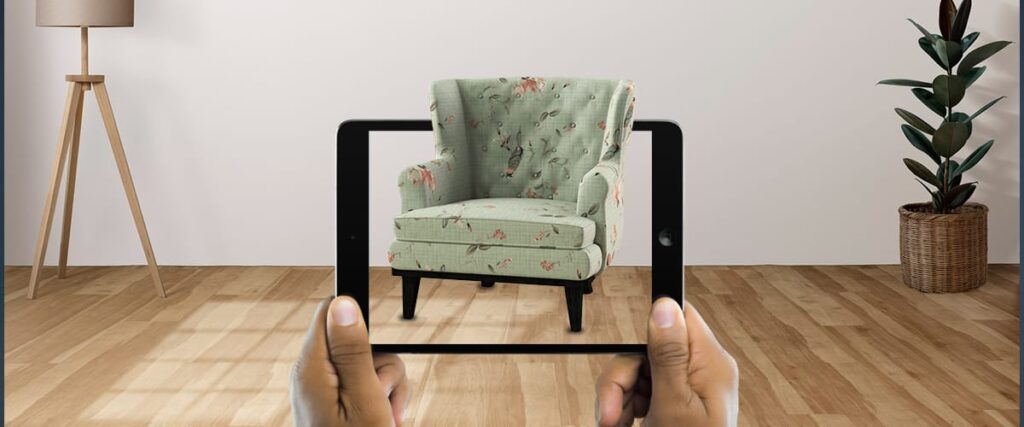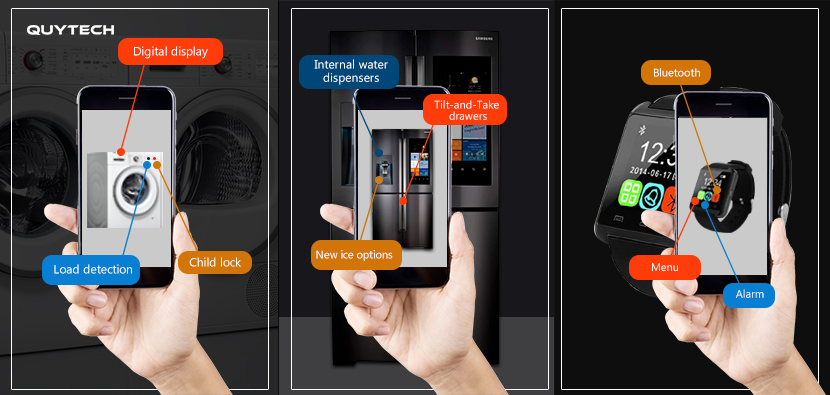
How AR Emphasizes E-commerce??
While in-person store shopping has returned to normal, many customers still prefer to shop online. For example, with the help of Augmented Reality (AR), shoppers can envision themselves in clothing or visualize how a paint color will look on their walls before making a purchase. AR technology bridges the gap between online and in-person shopping experiences, offering customers the convenience of virtual try-ons and previews.
Several companies are incorporating AR technology into their apps to enhance the customer buying experience. AR shopping offers benefits such as improved customer satisfaction and an increased likelihood of repeat purchases, which is advantageous for businesses. This technology can be accessed through various devices, including smartphones, tablets, smart glasses, or virtual reality headsets. Depending on the device and app, AR shopping can seamlessly integrate into social media platforms, online marketplaces, or brand websites.

PC: Nick Kolvin
Features Of Augmented Reality In E-Commerce:
1. Virtual Try-on Facilities:
The biggest fear of online shopping is fitting issues; whether it’s a dress, furniture, shoes, or anything else, the concern always lingers that it won’t meet your requirements. However, with the assistance of AR, this fitting issue can be effectively eliminated.
It helps online shoppers comprehend what they are purchasing and how it will meet their needs. Consequently, conversion rates are boosted, and return rates are reduced. In India, where the culture revolves around “1st try then buy,” AR proves to be an excellent solution.
The virtual try-on facilities are available in brands like Nykaa, Ikea Home Shopping, and the Asian Paints app. These features allow customers to visualize products before purchasing, enhancing their shopping experience and increasing confidence in their choices.

2.Social Media Filtration:
AR social media filters play a crucial role in driving user engagement. With millions of active users on social media platforms, encountering branded Augmented Reality filters increases the likelihood of sharing experiences in groups, stories, or feeds. This user-generated content is essential for brand promotion and visibility.
Subsequently, brand owners target consumers to digitally try out their products or samples, fostering confidence in their quality and suitability. This approach cultivates brand awareness and loyalty. Makeup and clothing brands, for instance, are reaping significant benefits from this strategy.
Brands utilize six types of AR filters, including Beauty filters, Real-world filters, Marker-based filters, Markerless filters, Position-based filters, and Fashion and virtual try-on filters. These diverse filters cater to different consumer needs and preferences, enhancing the overall user experience and engagement with the brand.

PC: Linked in
3. Sophisticated User Manual:
Customers don’t like technical user manuals as they are very lengthy for a person unaware of the terminologies. But, with the help of Augmented user manuals, it is easier and faster to just point out your smartphone on something you want to buy and it immediately provides all the necessary information in a simple version. Isn’t it amazing???
So, how does an augmented user manual work?? The AR manual uses tracking methods using pre-defined visual markers. It marks the users’ physical location and the products they want to interact with. After that, the AR collects the digital information of the products by mixing the real-world objects. The final user manual can be in any form: an image, text, video, or 3D animation.

PC: Wha Tech
4. Preview Options:
Have you ever shopped for furniture from the IKEA app? Well if you shopped from any other app that has an AR mechanism then before buying a product there is a preview option. So, if we put it in simple language, then the preview option provides customers a real-time glimpse of the product and whether it will look good when placed in their own space.
It is like a virtual try-on. This option can be found in beauty apps, clothing, furniture, electronics items, lenses, paint, etc. It is a crucial part of increasing customer buying experience.
How AR is helping E-commerce Businesses?
Increase Customer Engagement:
Customer engagement is the key parameter in enhancing a business. It depends upon factors like trust, loyalty, value for the money, ease, and relevance. Here, comes the AR that provides more personalized, interactive shopping experiences that will help brands to gain customer satisfaction.
For example, it offers Virtual try-ons, Preview placements, and product demos through text, image, or 3D video to ensure the customers are busy like they are doing offline shopping. Also provides social collaborations for the branding to enable customers to share, compete, and co-launching, reflecting a sense of community.
Reducing Return Rates:
In businesses, returns can’t be avoidable. In fact, the return rate is higher in e-commerce compared to in-store shopping. The obvious cause is, that the purchased product might not meet the customer’s expectations.
So, to avoid this obvious cause, Augmented Reality plays a crucial role. It enables customers to preview a product in their own environment, helping them understand whether it is worth purchasing. It really makes a big impact on reducing return rates.
Increase Conversion rates:
First of all, What is the Conversion Rate in e-commerce?
It is nothing but the percentage of users to one’s website that finish a desired goal or purchase out of the total no. of visitors. According to data, the combination of 3D and AR has marked significant impacts on conversion rates. The impact can increase the conversion rates by 200%.
3D technology helps retailers to display their products in a more accurate manner than regular 2D images. On the other hand, AR helps customers visualize the desired products in their own space without physically visiting in-stores.
For example, Shopify‘s AR technology on product pages helps customers and sellers or brands gain their respective profits. Hence, an increase in conversion rate occurs.

Enhancing Brand Awareness:
Brand Awareness or recognition plays a crucial role in boosting a business and producing loyalty for brands. One of the major advantages of using AR in product web pages is advertising which acts as an important part of brand recognition.
Augmented reality helps businesses in effective product visualization, user-engaging Print Ads, Virtual-try-ons, location-based advertising, gamification, and Social-media filters. This allows brands to create more inviting and fascinating shopping experiences for customers.
Boosting Sales and Revenue:
Augmented Reality marketing is a sure-shot method to increase sales and revenue growth. Its powerful user engagement features help users immersed in online shopping leading to decreased return rates and increased loyalty to brands. From small to medium to large businesses incorporating AR to increase their sales and revenues.
Conclusion:
In conclusion, augmented reality (AR) is proving to be a game-changer for e-commerce, revolutionizing the way customers shop online. By providing immersive and interactive experiences, AR enhances customer engagement, reduces decision-making barriers, and ultimately drives sales and revenue growth for businesses. As AR technology continues to evolve, its potential to transform the e-commerce landscape is boundless, promising even greater opportunities for businesses and consumers alike.